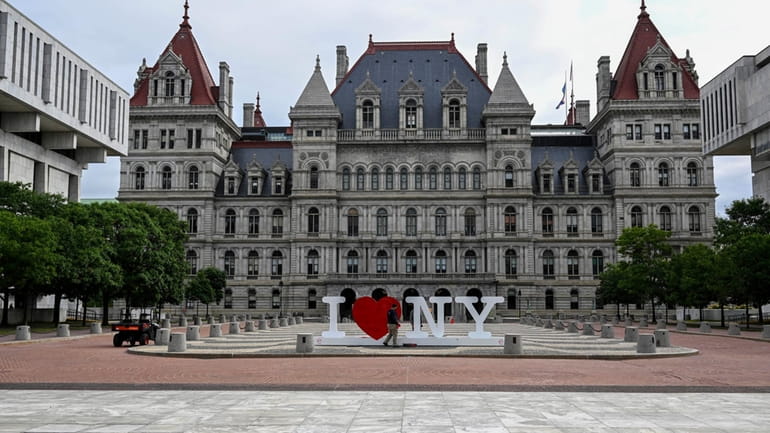NY state budget should raise short-term disability benefits for moms like me

The New York Capitol in Albany. There’s a real chance to update our short-term disability laws in the budget the legislature will approve in the coming days. Credit: AP/Hans Pennink
I was pregnant and my first thought was: Am I going to have enough money in my bank account to pay my bills when I leave work to recover from the birth of my new child?
In New York State, wage replacement benefits for short-term medical leave, which is what you go on when you have a baby, have been capped at $170 a week since 1989. Back then, a movie cost $3.99, a gallon of gas was $1.06, and a dozen eggs cost a buck.
As an insurance professional living on Long Island who assists New Yorkers in claiming their short-term medical leave benefits, also known as disability benefits, I was fortunate enough to know this ahead of time and we planned ahead. We cut out all the extras, bought diapers early on the deepest discounts we could find, and squirreled away as much savings as possible.
While 30% of short-term medical benefit recipients are women pre- and post-birth, not all of them are aware of the low statutory benefit. Among those who are, not all have the resources to plan ahead and save. Within the remaining 70% are folks who fall ill or are hurt off the job — a sudden occurrence for which no one can plan ahead.
As a result, in my professional role, I hear from New Yorkers making a claim for this insurance that the incredibly low reimbursement cap means they have to choose between putting food on their table or paying their rent. Ultimately, that's a choice between following a doctor’s orders to temporarily leave work and recover your health or going back to work too soon and suffering the consequences. For Black women, this can be a decision between life or death as they’re three times more likely to die while giving birth than white women.
Yet, in what is perhaps the oddest twist around this issue, if New York’s Paid Family Leave program had existed when I had my children, my husband would have had his wages replaced at a much higher level — currently about $1,100 per week. So here in New York, if you’re sick, injured, or pre- or post-pregnancy, your wages are capped at $170 a week while the person caring for you can have their wages reimbursed at more than six times that rate.
On a personal and professional level, I’ve been following this issue closely as it percolates in Albany. The Equity in Leave Act, introduced in December, would increase the short-term medical leave benefit cap starting in 2026 and phased in over four years, critically balancing the needs of workers, their employers, and the insurance companies that will implement the change.
With Gov. Kathy Hochul including a similar measure in her proposed state budget, and the State Senate and Assembly including versions in their one-house budgets earlier this month, there’s a real chance to get this update to our laws made in the budget the legislature will approve in the coming days.
We can’t wait any longer. The governor and legislature are close. For all of us, they must find a path forward, stay focused on the core issue, and bring short-term medical leave benefits in line with those offered through Paid Family Leave. We must have equity between New York State’s two paid leave programs.
This guest essay reflects the views of Rebecca Hanna, a Long Island mother of two and assistant vice president of product management for ShelterPoint, an insurance company that provides statutory short-term medical/disability coverage.
